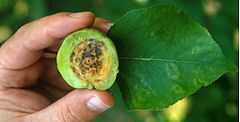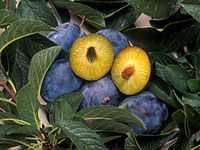Plum pox
| Plum pox | |
|---|---|
 | |
| Genome of PPV with proteolytic cleavage sites | |
| Virus classification | |
| Group: | Group IV ((+)ssRNA) |
| Family: | Potyviridae |
| Genus: | Potyvirus |
| Species: | Plum pox virus |
Plum pox, also known as sharka, is the most devastating viral disease of stone fruit from the genus Prunus. The disease is caused by the plum pox virus (PPV), and the different strains may infect a variety of stone fruit species including peaches, apricots, plums, nectarine, almonds, and sweet and tart cherries. Wild and ornamental species of Prunus may also become infected by some strains of the virus.
The virus is transmitted by aphids and by the transfer of infected plant material to new locations. Plum pox poses no danger to consumers, but it can ruin the marketability of stone fruit by causing acidity and deformities. The only way to manage the disease is to destroy all infected trees, which can cause significant economic losses.
Biology
The plum pox virus is a linear single stranded RNA virus.[1] There are six strains of plum pox virus: PPV-D, PPV-M, PPV-EA, PPV-C, PPV-Rec (Recombinant), and PPV-W. PPV-M isolates are more aggressive in peach, are aphid vectored more efficiently, and spread more rapidly in an orchard.[2] PPV-M has been reported to be seed transmitted, the other PPV strains are known not be transmitted through seeds. Both PPV strains M and D infest peach, plum, and apricot. PPV-C infects sweet and tart cherry naturally and is the only strain known to do so, it has infected other Prunus hosts experimentally.
Pathology

Several species of aphid transmit the virus including the plum-thistle aphid (Brachycaudus cardui),[3] the plum leaf curl aphid (Brachycaudus helichrysi) and the green peach aphid (Myzus persicae).[4] Winged aphids can transmit plum pox within an orchard, and over short distances (200–300 meters) to trees in nearby orchards. Unlike some other viruses, like barley yellow dwarf virus, PPV is not persistent in the aphid and is transferred from the mouthparts of the aphid between plants. Long distance spread usually occurs as a result of the movement of infected nursery stock or propagative materials. Once a plant is infected the virus is systemic and occurs in the cytoplasm of cells from all parts of the plant.
When a host tree is infected by plum pox, the infection eventually results in severely reduced fruit production, and the fruit that is produced is often misshapen and blemished. The presence of plum pox can also enhance the effects of other endemic viruses infecting various species of the genus Prunus, such as prune dwarf virus, Prunus necrotic (browning) ringspot virus, and apple chlorotic (yellowing) leaf spot virus, resulting in still greater economic losses.

In peach, infected trees may exhibit color-breaking symptoms in the blossoms. This appears as darker pink stripes on the flower petals and can be useful for early season surveys. Symptoms can be present in young leaves in the spring and /or on developing fruit. Some trees show no symptoms on leaves or fruit.
Not all infection in Prunus are characterized by a ring symptom on leaves. Several cultivars show yellowing line patterns and blotches, or necrotic ring symptoms on expanded leaves. Leaf distortion has also been observed. Infected fruit can develop yellow rings or blotches, or brown rings, and some plum and apricot fruit can be severely deformed and bumpy. The seed of many infected apricots and some plums show rings.
Many non-Prunus species, in at least nine plant families, have been infected artificially with one or more strains of the plum pox virus, and in some cases found naturally infected in the field. The maintenance of the virus in non-Prunus species complicates disease management.
Management

There is no cure or treatment for the disease once a tree becomes infected. Infected trees must be destroyed. Once the disease becomes established, control and prevention measures for plum pox include field surveys, use of certified nursery materials, control of aphids, and elimination of infected trees in nurseries and orchards.
Sources of resistance exist in Prunus, but are not common. A team of scientists from the United States and France has genetically engineered a plum pox-resistant plum called C5,[5] and the resistance can be transferred through hybridization to other plum trees. The transgenic plum expresses a plum pox virus coat protein, the plant produces the coat protein mRNA and it is processed by a system called post transcriptional gene silencing (PTGS), which functions like the plants immune system and is mechanistically similar to RNAi.[6] C5 provides a unique source of germplasm for future breeding programs worldwide. Similar success has not yet occurred in attempt to genetically modify other Prunus species, although these efforts are ongoing.
Distribution
| Disease Status | Country |
|---|---|
| Restricted Distribution | Albania, Austria, Canada, Cyprus, Czech Republic, France, Italy, Luxembourg, Moldova, Norway, Portugal, Southern Russia, Slovenia, Spain, Syria, Turkey, Ukraine, United Kingdom, United States, Australia |
| Widespread | Bulgaria, Croatia, Germany, Greece, Hungary, Poland, Romania, Slovakia |
| Introduced, Established | Azores, Bosnia-Herzegovina, Egypt, Former USSR including Central Asia, India, Lithuania |
| Introduced, Presumably Eradicated | Belgium, Netherlands, Switzerland |
| Present Status Unknown | Chile, Denmark |
| Modified from: Levy et al. 2000. Plum Pox Potyvirus Disease of Stone Fruits. American Phytopathological Society[7] | |
In the fall of 1999, plum pox strain PPV-D was detected in an Adams County, Pennsylvania orchard. This was the first time that plum pox had been found in North America. The infected areas in Pennsylvania have been quarantined to prevent the spread of the disease, and infected trees have been destroyed.[2]
Since this time, as a result of random surveying done in 2000, detection has also occurred in Nova Scotia and in Southern Ontario, particularly in the Niagara Region. Like the United States infection, the Canadian Food Inspection Agency has put into effect quarantine zones throughout Southern Ontario in a bid to prevent the spread of PPV. The virus has yet to be found in other areas of Canada which contain susceptible trees despite intense surveying. The Canadian plum pox eradication initiative has involved large numbers of samples tested for the plum pox virus. Samples are tested through a technology known as enzyme linked immunosorbent assay (ELISA). The University of Guelph - Laboratory Services Division has performed over 4,000,000 tests in the past 7 years in support of this initiative.
References
- ↑ International Committee on the Taxonomy of Viruses. 2002. Plum pox virus
- ↑ 2.0 2.1 APHIS. Plum Pox Potyvirus Disease of Stone Fruits
- ↑ Alford, David V. (17 July 2014). Pests of Fruit Crops: A Colour Handbook, Second Edition. CRC Press. p. 74. ISBN 978-1-4822-5421-1.
- ↑ Van Emden, Helmut Fritz; Harrington, Richard (2007). Aphids as Crop Pests. CABI. pp. 658–. ISBN 978-0-85199-819-0.
- ↑ GM Crop Database ARS-PLMC5-6 (C5) Center for Environmental Risk Assessment, 24 February 2009, Retrieved 25 April 2011
- ↑ Hily JM, Scorza R, Malinowski T, Zawadzka B, Ravelonandro M (October 2004). "Stability of gene silencing-based resistance to Plum pox virus in transgenic plum (Prunus domestica L.) under field conditions". Transgenic Res. 13 (5): 427–36. doi:10.1007/s11248-004-8702-3. PMID 15587267.
- ↑ Levy et al. 2000. Plum Pox Potyvirus Disease of Stone Fruits. American Phytopathological Society
External links
| Wikimedia Commons has media related to Sharka. |
- Contamination by the SHARKA virus in France: a synthesis
- West Virginia Department of Agriculture Plum Pox Virus Information
- Species Profile- Plum Pox (Potyviruses), National Invasive Species Information Center, United States National Agricultural Library. Lists general information and resources for Plum Pox.